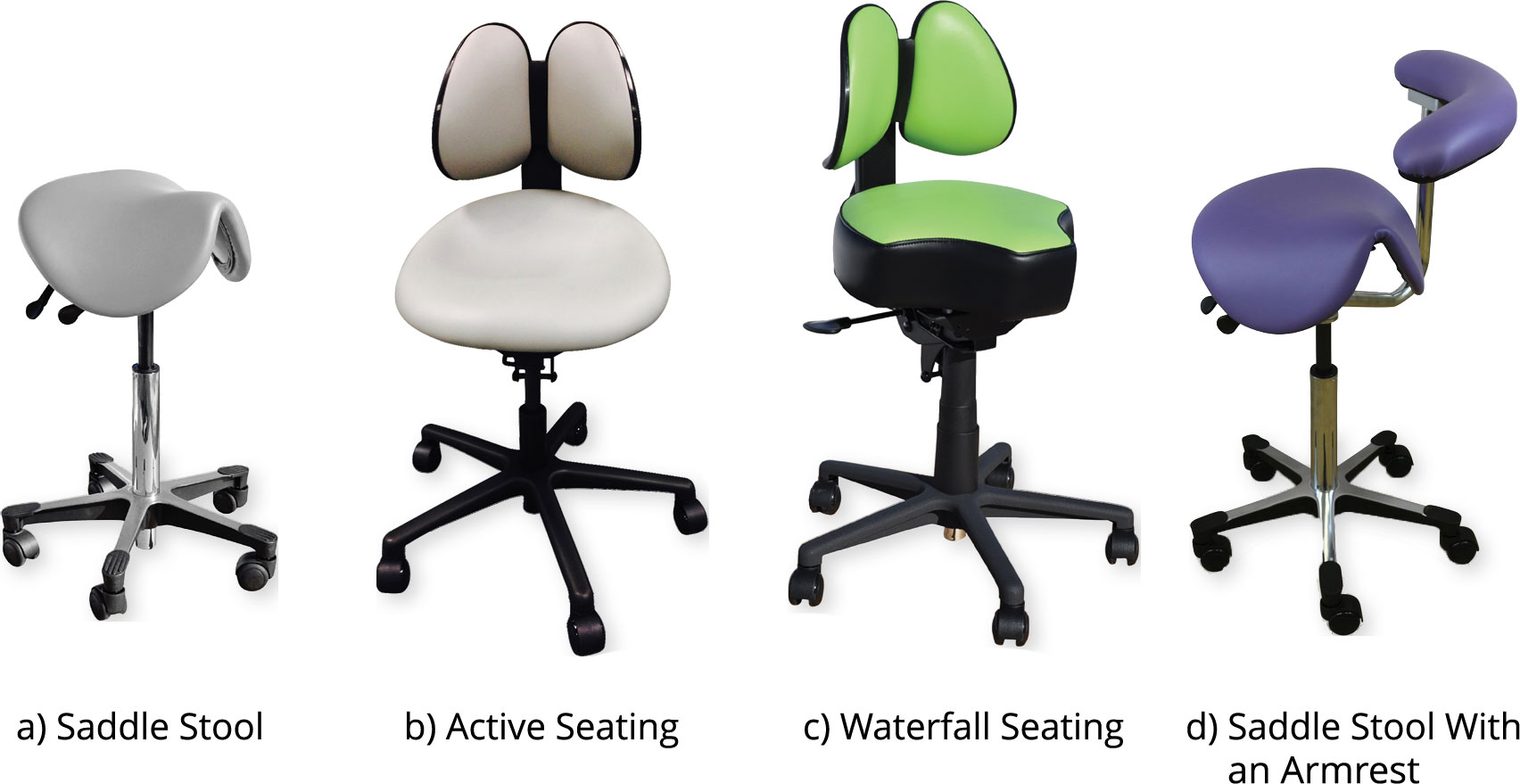Enhancing Ergonomics for Dentists and Surgeons: Promoting Health, Efficiency, and Career Longevity

ErgoPractice News – March/April 2025
By Jin Chang PhD
jchang@surgitel.com
Summary
Dentists and surgeons devote their professional lives to improving patient health, often engaging in complex procedures that require precision, concentration, and prolonged static or awkward positioning. However, inadequate ergonomics can result in chronic pain, musculoskeletal disorders (MSDs), fatigue, and shortened careers, with studies indicating that up to 80% of these professionals suffer from work-related pain, such as lower back discomfort, neck stiffness, or carpal tunnel syndrome.1-2 By adopting ergonomic practices, these healthcare providers can protect their physical health, boost performance, and sustain longer, healthier careers. This article outlines practical, research-supported strategies to improve ergonomics in their challenging work settings.
Understanding the Ergonomic Challenge
The repetitive movements, confined workspaces, and extended periods of standing, sitting, or leaning inherent in dentistry and surgery create distinct ergonomic risks. Dentists often bend over patients, stressing their necks, shoulders, and backs, while surgeons endure long hours on their feet, leading to leg fatigue and spinal strain. Ergonomics, the discipline of designing workspaces and routines to align with human physiology, provides solutions to alleviate these issues, enhancing comfort, efficiency, and long-term well-being.
Optimize Posture with Adjustable Equipment and Workplace Layout
A neutral posture is critical for ergonomic health. Dentists should maintain a straight back with legs apart, forming a stable tripod with their torso and lower body.3 Research indicates that seating with hips positioned higher than knees reduces lower back muscle activity and disc pressure.4 Clinicians should position their torso close to patients, with seat heights adjusted so the patient’s head is at waist level, keeping forearms parallel to the floor and near the body for a neutral stance.5-7 Dynamic stools (Figure 1) that allow spinal movement or frequent readjustment can further reduce lower back pain.2 Active seating, such as waterfall-style seats that slope downward, relieves thigh pressure and supports the legs and back, encouraging positional shifts to minimize injury risk.3
Surgeons benefit from standing platforms or anti-fatigue mats to ease lower body strain during extended procedures, with operating tables set to elbow height (around 66–77 cm above the floor) to maintain spinal alignment and reduce fatigue.8

Figure 1: ErgoComfort seating options.
Leverage Magnification, Lighting, and Ergonomic Instruments
Strain from poor visibility and heavy tools can be mitigated with ergonomic aids. Custom-fitted loupes with a steep declination angle—maximized to maintain a neutral neck posture of less than 20 degrees—support an upright head position, reducing neck strain while enhancing visual precision. An appropriate working distance—typically ranging from 35 cm to over 55 cm depending on the clinician’s height and working position—ensures comfortable ergonomics without the need to lean forward. LED headlights or advanced overhead lighting improve visibility and reduce eye fatigue. Additionally, ergonomically designed hand instruments help minimize hand and wrist strain, promoting sustained performance and long-term musculoskeletal health.
Incorporate Micro-Breaks, Stretching, and Patient Positioning
Static postures over long periods lead to muscle fatigue, but simple interventions can help. Dentists can take 5–10-minute micro-breaks between patients for stretches (e.g., shoulder rolls, neck tilts, or cat-cow movements), posture adjustments, and deep breathing to boost circulation and reduce tension. Surgeons can shift weight or relax arms during brief pauses. Patient positioning is equally vital: dentists should keep the patient’s head at waist level, tilting it back for upper arch work or forward for lower arch tasks, while surgeons adjust table heights to avoid spinal overextension.
For surgeons, a study by Hallbeck et al. demonstrated that 1–2-minute guided exercise breaks every 20–40 minutes during surgeries lasting 2–12 hours improved mental focus by 34% and physical performance by 57%, without disrupting workflow. Similarly, Park et al. found that targeted stretching micro-breaks for the neck, shoulders, back, hands, and legs maintained sterility and enhanced performance, with most surgeons intending to adopt the practice.8
Adopting a Team-Based Approach and an Ergonomic Program in Your Practice Offers Significant Benefits
Effective teamwork improves ergonomic efficiency—for example, dental assistants can adjust lighting or pass instruments, reducing the dentist’s need to twist or reach. Similarly, surgical teams can manage retraction and suction, helping to conserve the surgeon’s stamina.
Physical conditioning also plays a crucial role. Strengthening the core with exercises like planks and bridges, incorporating stretches for the neck, shoulders, and lower back, and maintaining hand and wrist mobility all promote resilience and flexibility. Cardiovascular training, yoga, and Pilates further enhance endurance and stability, giving clinicians a professional advantage.8-10
Clinicians often become so focused on procedures that they overlook their posture, leading to poor ergonomic habits. If you notice a colleague working with improper posture, speak up—supporting each other in maintaining good ergonomics helps prevent strain and discomfort. At the end of a long workday or week, you shouldn’t be sore from poor posture. Many clinicians instinctively hunch over to improve magnification and see more detail, but maintaining a more upright position with a longer working distance may require increasing loupe magnification to keep the same level of detail.
Embrace Technology, Training, and Awareness
Advanced tools and education solidify ergonomic practices. Robotic-assisted surgery enables surgeons to work from seated consoles, reducing physical strain, while dentists can use digital scanners to limit manual effort. Ongoing training—through workshops on posture, ergonomic assessments, or wearable posture devices—helps clinicians refine habits. Peer feedback on posture fosters a culture of support. Though high-quality equipment may involve upfront costs, the investment yields dividends in reduced fatigue and prolonged careers.
The Bigger Picture
Ergonomics extends beyond comfort to career sustainability. Chronic pain can drive burnout, lower productivity, or force early retirement, impacting both clinicians and patients. Employers and institutions play a critical role by funding ergonomic upgrades, offering training, and prioritizing staff well-being. In the demanding realm of healthcare, where precision and stamina are essential, ergonomics is a vital tool. By optimizing workspaces, using proper equipment, maintaining good posture, and integrating movement and fitness, dentists and surgeons can safeguard their bodies—their most essential asset—and enjoy healthier, longer, and more rewarding careers.
References
- Jodalli, Praveen S, Suchi Kurana, Shameema, Mallikarjuna Ragher, Jaishree Khed, and Vishnu Prabhu. “Posturedontics: How Does Dentistry Fit You?” Journal of Pharmacy And Bioallied Sciences 7, no. 6 (August 2015): 393–97. https://doi.org/10.4103/0975-7406.163463.
- Hayes, MJ, D Cockrell, and DR Smith. “A Systematic Review of Musculoskeletal Disorders among Dental Professionals.” International Journal of Dental Hygiene 7, no. 3 (July 16, 2009): 159–65. https://doi.org/10.1111/j.1601-5037.2009.00395.x.
- Guignon, Anne N. “Have a Seat: Ergonomic Conversations Turn to Dental Clinician Seating.” RDH Magazine, 26 Aug. 2015, rdhmag.com/career-profession/students/article/16405433/have-a-seat-ergonomic-conversations-turn-to-dental-clinician-seating.
- Valachi, Bethany. “Operator Stools.” Practice Dentistry Pain-Free: Evidence-Based Strategies to Prevent Pain and Extend Your Career, Posturedontics Press, 2008, pp. 93–95.
- Mandal, A. C. “The Seated Man (Homo Sedens) the Seated Work Position. Theory and Practice.” Applied Ergonomics, vol. 12, no. 1, Mar. 1981, pp. 19–26, doi:10.1016/0003-6870(81)90089-2.
- Tiedeman, Jeff. “New Concepts in Seating.” Sitting Comfortably, n.d., http://sitting-comfortably.co.uk/posture%20research%20publications.htm.
- Mandal, A. C. “Balanced Sitting Posture on Forward Sloping Seat.” A C Mandal, n.d., http://www.acmandal.com/.
- Schlussel, Andrew T., and Justin A. Maykel. “Ergonomics and Musculoskeletal Health of the Surgeon.” Clinics in Colon and Rectal Surgery 32, no. 06 (August 22, 2019): 424–34. https://doi.org/10.1055/s-0039-1693026.
- Kumar, Dodda Kiran et al. “Exercise prescriptions to prevent musculoskeletal disorders in dentists.” Journal of clinical and diagnostic research : JCDR 8,7 (2014): ZE13-6. doi:10.7860/JCDR/2014/7549.4620
- “ADA Ergonomic Stretches.” ADA, April 22, 2022. https://www.ada.org/-/media/project/ada-organization/ada/ada-org/files/resources/practice/health-and-wellness/ada_ergo_stretches.pdf?rev=3b1881c0636d48e585123b4218bae959.



